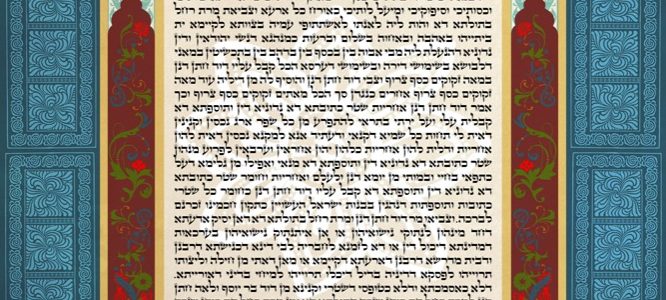Embodiment of Extravaganza: Baroque Ketubah
If you consider yourself and your stylistic preferences modest, simple, and down-to-earth, Baroque is just not the way to go. Baroque is strong, bold, attention-seeking, and never shy. Baroque is always in the spotlight, as its primary purpose was to draw attention, turn heads, and be a testimony of power, luxury, and class. Although we cannot say its influence is largely present in the modern day architecture, the remains of Baroque represent not only a memory of an extravagant age, but an artistic inspiration that lives on. To this day, the mark that Baroque has left on architecture is examined, studied, adored, and considered a treasure.
Baroque is a movement that originally appeared in the 17th century, following the Renaissance, under a great influence of the Catholic Church. At first, the very purpose of Baroque was to oppose the Protestant Church and everything it represented. Therefore, since Protestant architecture was characterized by simplicity and modesty, Baroque was supposed to be the complete opposite – as extravagant and loud as ever. It is safe to say that Baroque did not fail to amaze, and it even may have exceeded some expectations. Baroque brought grandeur to life, emphasizing colors, shapes, and forms; relying on contrast and variety of details, and creating an overall sense of luxury. Needless to say, Baroque triggered many heated discussions and divided artists and admirers. Some found Baroque fascinating and mesmerizing, while others detested its tackiness and even perceived it as utterly bizarre.
As far as architecture is concerned, Baroque seems to have had the greatest impact on churches, which is not surprising at all given the circumstances of its creation. Some of the most famous staples of Baroque in architecture include St. Peter’s Basilica, Chair of Saint Peter, Quadratura in the Jesuit Church, and The Entry of Saint Ignace into Paradise, among others. It is also important to note that Baroque did not only mark architecture, but other spheres of art, including music, theater, and ballet.
For some, Baroque may have been a lifestyle, representing freedom of expression, and love for the details. The Tehran Baroque ketubah is a representative of the Persian Jew community, embracing the traditional Persian Jewish style, very much resembling the bold works of Baroque. It is daring, colorful, and eye-catching, and every single detail in this Baroque ketubah piece has been carefully selected. For more Baroque-inspired ketubah pieces, make sure to check out our full Baroque ketubah collection.






